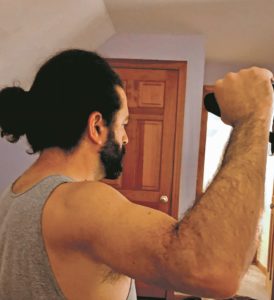Rotator cuff troubles. We hear about them all the time — everyone from famous pitchers, to house painters, to Aunt Myrtle seems to have them.
What is the rotator cuff, anyway, and why does it get hurt so often? The shoulder is a ball-and-socket joint, but, as I wrote last month, it’s a precariously arranged one.
The top of the humerus, the upper arm bone, is the ball. It’s balanced on a shallow socket formed by the scapula, your shoulder blade, and the clavicle, or collar bone. The rotator cuff is a group of four muscles (supraspinatus, infraspinatus, teres minor, and subscapularis) that attach the humerus to the shoulder blade — they hold it all together.
Rotator cuff injuries aren’t usually the action-packed kind — trauma caused, for example, by a high-speed ski crash or a “foosh” (fall on an outstretched hand). More often, inflammation (a.k.a. tendinitis) is the culprit, caused by overuse or repetitive overhead motions like throwing a ball or painting.
Degenerative changes that occur later in life are also hard on the rotator cuff.
The good news is, with the exception of substantial tears, surgery often isn’t necessary to heal these small but important muscles.
You should see an expert if you have symptoms of serious shoulder trouble, such as pain when sleeping on your side or reaching overhead or behind your back, or if you have loss of motion or weakness in the arm. An orthopedic doctor or a physiatrist can give you a specific diagnosis and refer you to physical therapy, where the right exercises for your case can be put together.
But there are things you can do to prevent occasional shoulder aches and pains from developing into bigger problems. First, the basics: practice perfect posture. Yes, this again! There’s more space within the joint when you sit or stand up straight, which means less chance of pinching the uppermost tendon, the supraspinatus.
Avoid carrying heavy objects at your side, as the downward pull strains the muscles of the shoulder. Another move to avoid: reaching with your thumb turned downward; that puts the squeeze on the tissue inside the shoulder. And before strenuous activity, warm up by doing range-of-motion and dynamic stretches. This is especially important for high-speed activities such as baseball and tennis.
Beyond the basics, there are ways you can actually strengthen the rotator cuff and shoulder blade muscles. Most traditional training programs emphasize the large muscles in the chest and arms, but these small ones are truly important. Here are two to add to your routine.

External rotation: Here, the rotator cuff is working to stabilize and turn your arm. Anchor an elastic band around a sturdy post, at the level of your hips. Grasp the free end of the band in your right hand and stand with your arm stretched out to your side at shoulder height, and with your elbow bent at a right angle so your forearm and fist are pointing straight ahead. Place your left foot forward and engage your core. Keep the upper arm level as you roll it upward, raising the forearm into a vertical position. Slowly release. Do 8-15 repetitions with each arm.
Prone posture work: This is for the muscles that attach the shoulder blades to the spine. Lie face down with your forehead on the floor, arms at your sides, palms facing your thighs. Draw your shoulder blades toward your spine and down your back as you raise your head, arms, and chest. Look at the floor underneath your face, taking care not to tip the chin up or down. Reach your hands back toward your knees. Hold for 5-10 seconds, then slowly lower yourself to your starting position. Work up to doing 2-3 repetitions of 30-60 seconds each.



